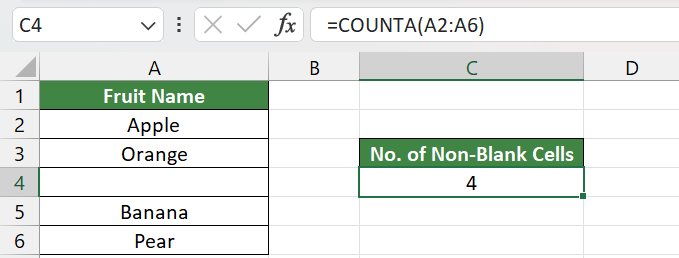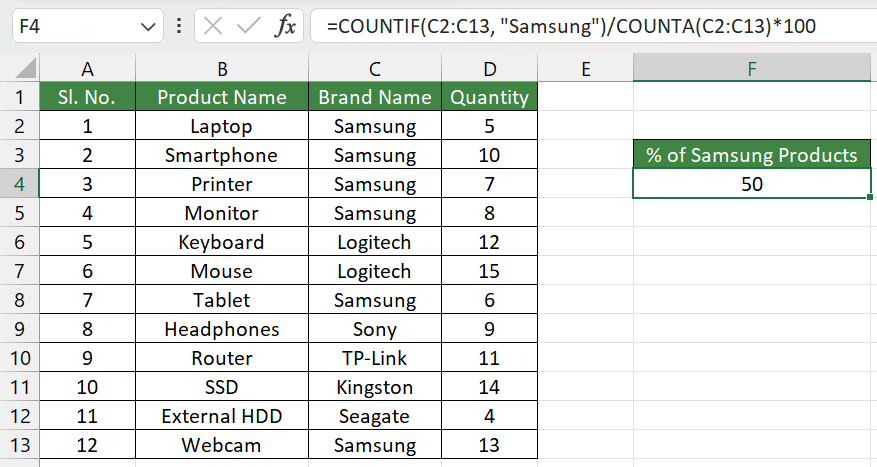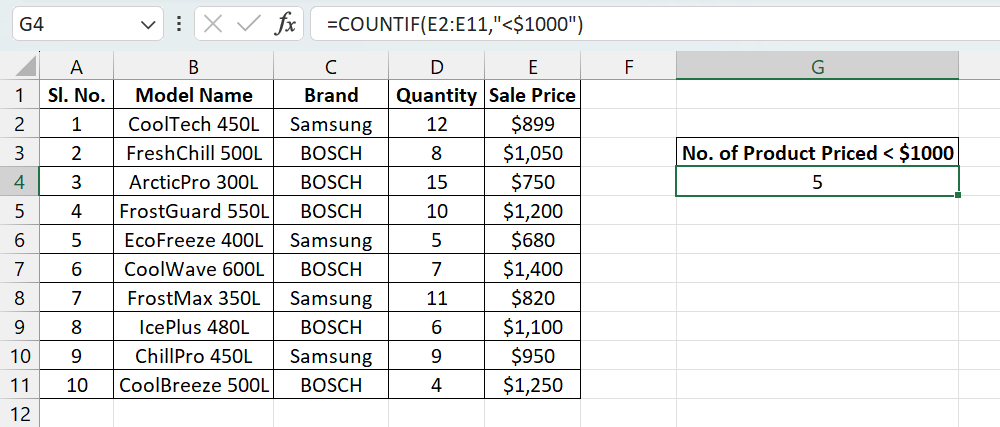The COUNTA function is a great tool for tasks like tallying survey responses, tracking attendance, or organizing inventory, as it counts all non-empty cells, regardless of the data type. It helps count cells with numbers, text, dates, or even errors, making it an effective tool in your spreadsheets.
Syntax of COUNTA Function in Excel
=COUNTA(value1, [value2], ...)| Argument | Description |
|---|---|
value1(required) | A cell, a range of cells, or an array where you want to count non-empty cells. |
[value2](optional) | Additional cells, ranges, or arrays to include in the count. |
Examples of COUNTA Function
Count Non-Empty Cells in a Cell Range
Count non-empty cells in a cell range using the COUNTA function.

- Formula:
=COUNTA(A2:A6) - Description: The function counts the number of non-empty cells in the range A2:A6 and provides numerical output i.e count of non-blank cells in cell C4.
- Output:
4
Count Non-Empty Cells in Multiple Cell Ranges
Count non-empty cells across multiple ranges using the COUNTA function.

- Formula:
=COUNTA(A2:A6,B2:B6) - Description: The function counts the number of non-empty cells in the multiple ranges A2:A6 and B2:B5 and provides numerical output i.e count of non-blank cells in cell D4.
- Output:
8
Using COUNTA with Other Functions in Excel
Using COUNTA with COUNTIF Function
Calculate the percentage of cells containing the word “Samsung”.

- Formula:
=COUNTIF(C2:C13, "Samsung")/COUNTA(C2:C13)*100 - Description: COUNTIF counts the number of cells containing the word “Samsung” in the range C2:C13. COUNTA calculates the total number of non-empty cells in the range C2:C13, providing the total number of entries. Dividing the COUNTIF by COUNTA will provide the percentage of cells containing a particular word
- Output:
50%
Related Functions of COUNTA
Using COUNT
The COUNT Function counts only numeric values and ignores text and blank cells.
- Syntax:
=COUNT(value1, [value2], ...)- value1: The first cell, range, or array where you want to count numeric values.
- value2: Additional cells, ranges, or arrays.
Using COUNTIF
The COUNTIF Function Counts cells based on a specific condition, making it helpful for counting non-blank cells that meet particular criteria.
- Syntax:
=COUNTIF(range,criteria)- range: The range of cells to apply the criteria to.
- criteria: The condition or criterion to count cells by. This can be a number, expression, cell reference, or text.

Example: =COUNTIF(E2:E11,"<$1000") counts the number of products priced more than $1000 by counting the product prices in the range E2:E11 using the criteria "<$1000".
Using COUNTBLANK
The COUNTBLANK Function counts only empty cells within a range, essentially the inverse of COUNTA.
- Syntax:
=COUNTBLANK(range)- range: The range of cells in which you want to count blank cells.

Example: =COUNTBLANK(C2:C11) counts the number of blank cells in the range C2:C11.
Common Errors While Using COUNTA Function
#VALUE! Error
This error is rare with COUNTA, but it can occur if you’re using an invalid range.
Counting Hidden Cells
COUNTA includes hidden cells in its count, which may not be desirable in filtered lists.
Miscounting Due to Spaces
Cells with only spaces appear blank but are counted by COUNTA as non-empty. Ensure cells are genuinely empty to avoid inaccurate counts.
COUNTA Function – Tips and Best Practices
- Use COUNTA for Non-Empty Cell Counts: If you need to count cells that contain any type of data, COUNTA is ideal.
- Combine with IF for Conditional Counts: Pair COUNTA with IF functions for more specific counting.
- Watch for Hidden or Filtered Cells: COUNTA counts all visible and hidden cells in a range. Use COUNTVISIBLE (with VBA) or subtotal functions if you need to count only visible cells.
Conclusion
The COUNTA function in Excel is a versatile tool for counting cells that contain any data, making it ideal for a wide range of data tracking needs. By understanding its applications, you’ll be able to use COUNTA efficiently and avoid common pitfalls.
Frequently Asked Questions (FAQs)
-
What is the Syntax of COUNTA Function in Excel?
=COUNTA(value1, [value2], ...)is the syntax of the COUNTA Function in Excel. COUNTA counts non-empty cells in an individual or multiple cell ranges. -
What is the difference between COUNT and COUNTA?
COUNT counts only numeric cells, while COUNTA counts all non-empty cells, including text and dates.


